- The market seems to persistently underestimate Aflac
- AFL has raised the dividend for 39 consecutive years
- The Wall Street consensus outlook suggests very limited upside at current levels
- The market-implied outlook is moderately bullish to early 2023
- Selling covered calls on AFL is worth considering
Shares of American insurance giant Aflac (NYSE:AFL) have rallied over the past year, with a 12-month total return of 21%, as compared with 10.8% for the S&P 500. The stock drifted through the first half of last year but rallied off its Sept. 21, 2021 low of $51.35 and is currently 8.4% below its 12-month closing price high of $66.04 on Feb. 8, 2022.
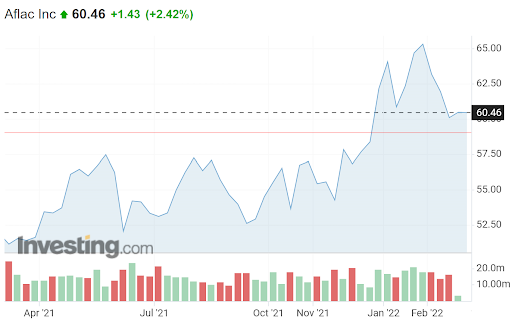
Source: Investing.com
Two major drivers for the share gains are:
- an impressive run of consensus-beating quarterly earnings
- rising interest rates which is good for insurance companies in general

Source: E-Trade
The Columbus, Georgia-based life and health insurance giant has posted an impressive 39 consecutive years of dividend growth. The trailing 3-, 5- and 10-year dividend growth rates are 9.8%, 10.6%, and 8.2% per year, respectively and the current yield is 2.7%.
With these numbers, AFL should be able to support total annual returns of 12.5% in the coming years, according to the Gordon Growth Model (using the three-year dividend growth rate). For context, AFL’s trailing 5-, 10-, and 15-year annualized total returns are 12.4%, 11.7%, and 7.8% per year, respectively.
On Sept. 16, 2021, I assigned a buy rating to AFL. From that date to today, the shares have gained 9.15% (not including dividends) vs. a 6.78% decline for the S&P 500. In September, the Wall Street consensus rating was neutral and the consensus 12-month price target was close to the share price at that time. I noted that the analysts appeared to have been too conservative on AFL’s earnings growth potential for some time. The fundamentals looked reasonable then and, of course, the company’s long-term consistent growth could not be overlooked.
Along with the fundamentals and the Wall Street consensus outlook, I rely on the probable outlook that is implied by options prices, known as the market-implied outlook. The price of an option on a stock reflects the market’s consensus estimate of the probability that the price of the stock will rise above (call option) or fall below (put option) a specific level (the option strike price) between now and when the option expires.
By analyzing the prices of put and call options at a range of strike prices, all with the same expiration date, it is possible to build a probable price forecast that reconciles the options prices. This is the market-implied outlook and represents the consensus view among buyers and sellers of options. For a deep dive into the theory of the market-implied outlook, I recommend this (free) monograph from the CFA Institute. In September, the market-implied outlook for AFL to early 2022 was bullish.
I have calculated the market-implied outlook to early 2023 and compared this with the Wall Street consensus outlook, as in my previous analysis.
Wall Street Consensus Outlook For AFL
E-Trade calculates the Wall Street consensus outlook for AFL by aggregating the views of eight ranked analysts who have published ratings and price targets over the past 90 days. The consensus rating is a buy and the consensus 12-month price target is 7.6% above the current share price. As recently as late February, the consensus rating was neutral. E-Trade’s version of the Wall Street consensus rating was also neutral back in September.
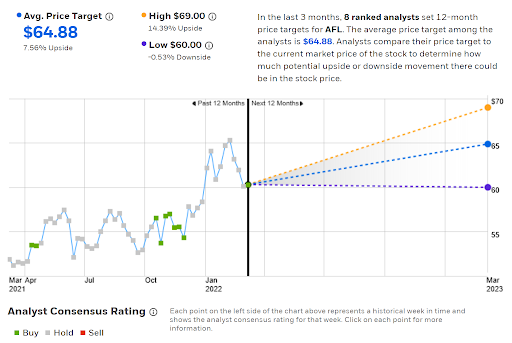
Source: E-Trade
Investing.com calculates the Wall Street consensus using ratings and price targets from 13 analysts. The consensus rating is neutral and the consensus 12-month price target is 4.4% above the current price.
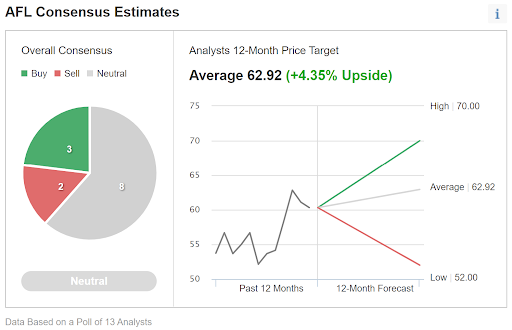
Source: Investing.com
The Wall Street consensus outlook is either bullish or neutral, depending on the source of the consensus. The consensus 12-month price target is either 4.4% or 7.6% above the current share price, for a total 12-month expected return of 7.1% to 10.3% (average of 8.7%).
Market-Implied Outlook For AFL
I have calculated the market-implied outlook for AFL for the 10.3-month period from now until Jan. 20, 2023, using the prices of options that expire on this date. I selected this expiration date to provide a view for the balance of 2022 and into early 2023 because the options expiring in January are among the most actively traded.
The standard presentation of the market-implied outlook is a probability distribution of price return, with probability on the vertical axis and return on the horizontal.
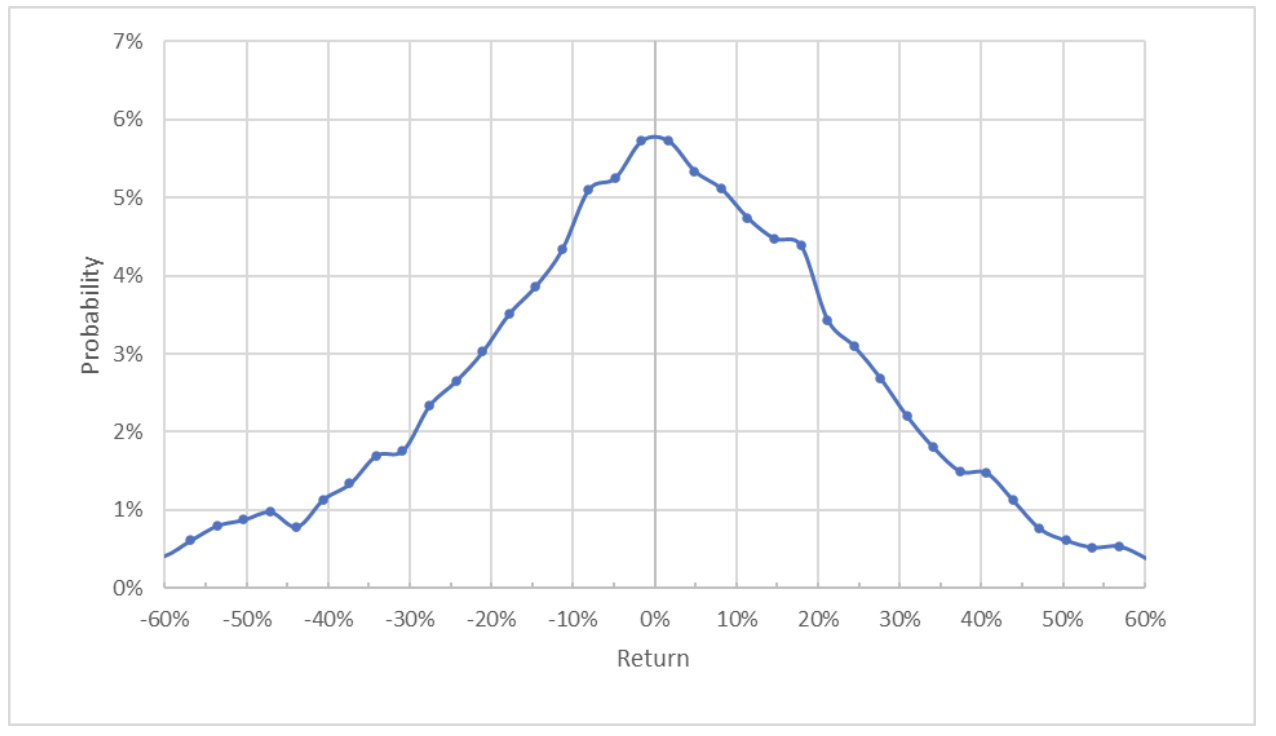
Source: Author’s calculations using options quotes from E-Trade
The market-implied outlook for AFL to Jan. 20, 2023, is generally symmetric, with comparable probabilities of positive and negative returns of the same magnitude. The annualized volatility calculated from this distribution is 30.1%.
To make it easier to directly compare the probabilities of positive and negative returns, I rotate the negative return side of the distribution about the vertical axis (see chart below).
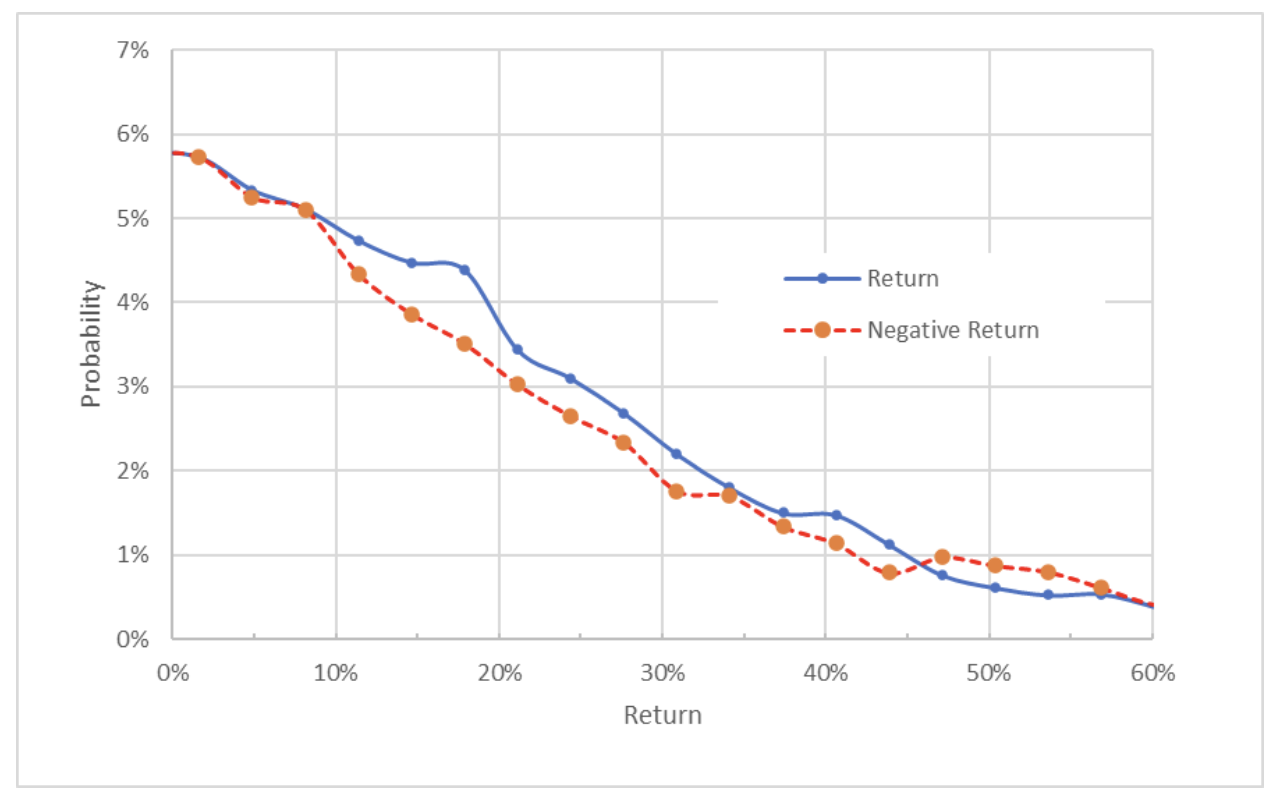
Source: Author’s calculations using options quotes from E-Trade
This view shows that the probabilities of positive returns tend to be higher than the probabilities of negative returns of the same size across a wide range of the most probable outcomes (the solid blue line is above the dashed red line across much of the chart above). This is a bullish outlook. The spread in probabilities favoring positive returns is substantially less than in my September analysis, however. In other words, this market-implied outlook is less bullish than the one that I calculated in September, prior to AFL’s big gains.
In the current market conditions, income-oriented investors may want to consider selling covered calls against AFL. At the time that I pulled options quotes for AFL, the shares were trading at $59.61 and it was possible to sell call options on AFL expiring on Jan. 20, 2023, with a strike of $60, for $6.50 (this was the bid price). Buying AFL and selling these options, the income from the option premium is 10.9% ($6.50/$59.61) over the next 10.4 months. In addition, this position is expected to provide $1.20 in dividends (three quarterly payments) over this same period, for a total income of 12.9%.
Summary
AFL has a notable, long-term history of generating consistent earnings and dividend growth. The shares have risen substantially, but the current valuation is still reasonable and the current price is more than 8% below the 12-month high. The backdrop of rising interest rates is a tailwind for AFL.
The Wall Street consensus rating is either neutral or bullish, depending on which version of the consensus is used, and the consensus 12-month price target implies a total return of 8.7%. This must be considered in light of analysts’ recent tendency to underestimate the company, however.
The market-implied outlook to Jan. 20, 2023, is modestly bullish, although less so than in September. The expected volatility calculated from the market-implied outlook is 30.1%, which is not especially high for an individual stock but is fairly high for a fairly staid company like AFL. I am maintaining my bullish outlook on AFL, but conservative investors may want to consider selling covered calls to buffer potential declines.
Which stock should you buy in your very next trade?
AI computing powers are changing the stock market. Investing.com's ProPicks AI includes 6 winning stock portfolios chosen by our advanced AI. In 2024 alone, ProPicks AI identified 2 stocks that surged over 150%, 4 additional stocks that leaped over 30%, and 3 more that climbed over 25%. Which stock will be the next to soar?
Unlock ProPicks AI